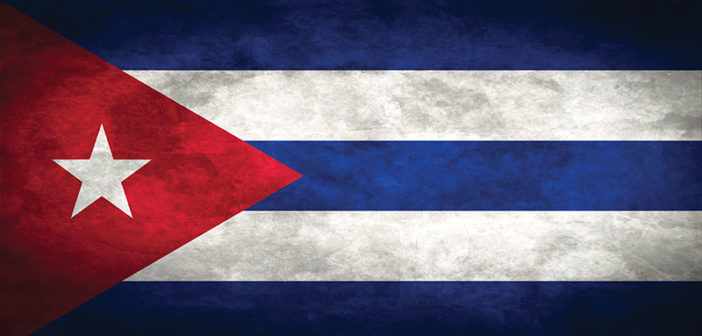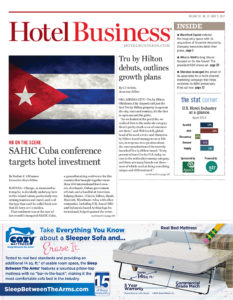HAVANA—Change, as measured as it may be, is decidedly underway here in this island nation, particularly concerning tourism and travel, and is of the type that can’t be rolled back now that it’s been set in motion.
That sentiment was at the core of last month’s inaugural SAHIC Cuba, a groundbreaking conference for this country that brought together more than 200 international hotel owners, developers, Cuban government officials and a handful of American lodging chains—Choice, Hilton, Hyatt, Marriott, Wyndham—who, with other companies, including U.K.-based IHG and Indonesia-based Archipelago International, helped sponsor the event.
Held at the Meliá Cohiba hotel overlooking the Malecón and the sea, the investment conference offered a variety of informative sessions ranging from a look at Havana’s history, to firsthand stories by Cuban lodging executives and developers, to government tourism officials describing the current state of the hotel industry here, including plans around technology and infrastructure.
Designers spoke about the need for sustainability in hotel projects as developers investigate hotel sites determined by the government, as well as issues regarding the supply chain for needs such as FF&E and general products for hotels. Presentations also were made around the impact of increasing cruise and airline business into the country.
Of the American chains present, only Wyndham Worldwide’s Louis Alicea, senior director of development, Latin America & Caribbean, moderated a session (regarding cruise ship business).
None of the chains’ representatives would comment on their companies presence at the event or plans for the future here.

Cuba’s Vice Minister of Tourism Luis Miguel Diaz Sánchez (left) and Arturo Garcia Rosa, SAHIC’s president/founder, welcomed attendees to SAHIC Cuba.
According to Arturo Garcia Rosa, president and founder of the SAHIC Latin America Hotel Investment Conferences, the Cuba conference was two years in the making, with SAHIC executives working with Cuban government officials to bring an event here.
“We are so excited because the idea is to put people from all over the world together with the key people from Cuba who will be their partners—to do business here you need a Cuban partner,” he said, noting that attendees could share information and “try to identify who would be the best partner for future projects.” He added that “the investment process is a long process.”
The executive said the Cuban government, which determines projects in the country, is looking for “knowledge, expertise and networking. The people from abroad think they are looking for money… The main goal is to find the right partners who can bring knowledge, expertise, track records with huge recognition.” Rosa added that “in some cases, they are looking for the JV to build the investment.”
Rosa said the Cuban government “supports us as much as we can ever have in mind that they could do… I think this will be a very good beginning.”
This beginning largely started heating up in March 2014 when Cuba’s National Assembly passed the so-called Foreign Investment Law aimed at bringing capital into the communist country across a range of sectors, such as real estate development, to lift its economy, and offered a variety of incentives, including significant tax breaks, depending on the investment model.
While the U.S. maintains an economic embargo on the Republic originally set in place October 1960 under the administration of President Dwight D. Eisenhower, and which was then broadened in February 1962 by President John F. Kennedy—thereby preventing investment by American companies—in late 2014, former President Barack Obama in his efforts to normalize relations with Cuba had the U.S. government issue a series of new regulations that eased the restrictions on certain travel, financial and trade activities.
Since then, several U.S. airlines, including Delta and JetBlue, have established routes to Cuba and Americans can now cruise from the U.S. aboard a number of ships.
Also, prior to its acquisition by Marriott International Inc., Starwood Hotels & Resorts Worldwide Inc. inked a contract to manage several hotels, notably the now-branded Four Points by Sheraton in Havana.
And despite Americans not being able to travel strictly as tourists to Cuba—U.S. visitors must qualify within 12 government categories—some 613,000 visitors traveled to Cuba last year, 74% more than in 2015, making them the second largest group behind historic leader, Canada, according to SAHIC data. Additionally, during the first two months of 2017 (latest figures available), U.S. visitors increased by 125% compared to the same period last year.
Overall, four million tourists went to Cuba in 2016 and in first-quarter 2017, there was a 15% increase in the number of total arrivals compared to Q1 2016.
According to Janet Ayala Diaz, director of promotion and communication, Ministry of Tourism of Cuba, as of Q1, North America represented 45% of all visitors, Europe 33% and Latin America 16% (the remaining 6% was not defined).
Both independent and branded non-U.S. hotel companies have had a presence on the island for a long time, largely invited by the Cuban government, and that footprint is increasing.
For example, during the SAHIC Cuba conference, a select group of attendees was given a pre-opening tour of the five-star Gran Hotel Manzana Kempinski La Habana. Located within the historic Manzana de Gómez building, the hotel, done in partnership with local hotel group Grupo de Turismo Gaviota SA, has 246 rooms and suites and a rooftop infinity pool and lounge that puts guests at eye level of the upper-floor architecture of Old Havana’s most iconic buildings.
A similar management agreement between Spain’s Iberostar Hotels & Resorts and Gran Caribe is set to reposition the Riviera Hotel, located across from the Meliá Cohiba, the SAHIC Cuba conference hotel.
Also a Spain-based company, Meliá Hotels International earlier in Q2 said it would add eight hotels to the 27 it manages in Cuba.
Currently, there are a handful of government-controlled Cuban hotel companies: Grupo de Turismo Gaviota S.A.; Cubanacan; Gran Caribe; Islazul; and Cubasol (which also does mixed-use projects, such as second homes for foreign investors, which is a distinct paradigm shift for the island), and foreign investors looking to do lodging projects are required to partner with a state-owned business either via a management agreement or as the minority partner in a JV.
Concerning partnerships, Rosa said Gaviota primarily is looking for knowledge and expertise whereas Gran Caribe, Islazul and Cubanacan are looking for those attributes as well as 50:50 joint venture investment partners.
There’s currently an estimated 67,000 hotel rooms on the island, according to SAHIC data, with a government goal of reaching approximately 104,000 keys by 2030.
Pointing to the government’s development goal, Rosa said, “There’s also a lot of opportunity for architects, designers, developers and general contractors.”
Keynote speaker David Scowsill, president/CEO of the World Travel & Tourism Council, noted, “The lodging and hospitality industry is part of a much wider travel and tourism sector, and the economics and megatrends, both regional and local, directly affect what happens here.”
He said last year, the sector contributed almost $9 billion to the Cuban economy, representing just under 10% of the country’s GDP, and accounted for some 500,000 jobs, or one in 11 jobs in Cuba.
Citing Cuba as “one of the safer countries of the world,” the Ministry of Tourism’s Diaz noted the country has “a lot of touristic attributes” with 272 national monuments and 340 museums. Speaking through a translator, she said, “We know the main challenge of our destination would be to manage the avalanche of visitors from abroad who are activating our country.” She added that the country is committed to “welcome equally all those who visit…with the highest quality and hospitality, professionally showing the authentic Cuba that every day is being developed and improved.”
Another presenter at the SAHIC Cuba conference, Alina Hernandez Montero, head of the teaching department of the National Institute of Economic Research, said it’s anticipated that in 2017, “tourism-associated activities would grow by 8%.”
“This country has an extraordinary history,” added Scowsill. “With such a rich and diverse—almost unique—culture, it deserves to retake its place as one of the most important tourism economies in the world.”
Rosa expects sooner, rather than later, that Cuba will become the second most-visited destination in Latin America behind Mexico, possibly as soon as the next five to 10 years.
“This is a way of no return,” said Rosa of the advancements that have been made in travel and tourism.
That said, the SAHIC executive was asked how Cubans view the changes and if there’s concern.
“The culture that they have is so strong and they love it. They know they need a lot of things, but they love who they are,” explained the executive, regarding the perception that after a time, the onslaught of tourists and foreign businesses will overrun the island nation and transform it. “They will not sell their culture very easily. They are open to exchange their culture with other practices.
“Of course, you will see McDonald’s [theoretically]and I have no doubt there will appear not one but more than one in [Old Havana],” Rosa added, but he’s not worried. “The Cuban culture is so rich, so strong. The people are very well prepared.”
Rosa added that some world leaders could be thinking of closed-door policies to protect their countries, but, he said, “I think the world will be global or will be nothing. For me, there is not any doubt about that.” HB
Variety of voices heard at SAHIC Cuba 2017
HAVANA—Those in the know about Cuba—and those wanting to know more—found themselves in lively exchanges during any given moment at the first SAHIC Cuba conference.
Whether during sessions or at lunch, waiting for the shuttle bus to Old Havana or relaxing on the lawn during a reception at the legendary Hotel Nacional de Cuba, there was an overall eagerness expressed by attendees and presenters to absorb as much information as possible during the two-day event.
Among the key executives Hotel Business caught up with at the conference was Eduardo J. Acosta de Arriba, president of Gran Caribe Grupo Hotelero, one of five leading hotel groups in Cuba. Gran Caribe operates four- and five-star-level hotels—representing some 2,000 keys in five Cuban destinations—including Hotel Nacional as well as the iconic 147-year-old Hotel Inglaterra, one of three hotels Starwood Hotels & Resorts (now Marriott) had in negotiated plans to manage.
Acosta de Arriba told Hotel Business through a translator that over the past three years, the number of visitors to Cuba has doubled and indicated Cuban hoteliers are looking to meet the demand. “Our hotel groups are working on that,” he said. “[We are] increasing the number of rooms. We are trying to offer the best quality. The people from the United States are increasing more than 18%.”
The executive said the company’s plan is to increase the number of rooms to some 10,000 over the next seven to eight years.
In addition to providing consistent quality, the company also is addressing technology, which is still challenging here. “We need to improve the technology infrastructure to give the client better service,” said Acosta de Arriba.
He said adding brands such as Marriott, Hilton, Four Seasons, etc., in a greater capacity in the future would make Cuba more attractive and improve the local system. The executive “believes in competition,” and while competition is going to raise the bar for both services and the quality of hotels, he welcomed the fact that there’s going to be more. “They’re going to force us to be better than we are,” said Acosta de Arriba, although he cited Cubans and their hospitality as one of the best assets for being in the hotel business here now. “They are made for the industry,” he said.

Archipelago President/CEO John Flood (with mic) gave the international operator’s perspective on doing business in Cuba. With him are, left to right, Eric Rodriguez, VP of Sunwing Travel Group; Luis Mirabelli, VP of development, Latin America/Caribbean, Wyndham Hotel Group; and moderator Clay B. Dickinson, managing director, Latin America/Caribbean, JLL Hotels & Hospitality Group.
John Flood, president/CEO of Archipelago International Hotels, Resorts and Residences, was at the conference with his team as both a speaker and an exhibitor. His Indonesia-based company, which operates more than 200 hotels across seven brands in a variety of segments, was recently invited by the Cuban government to participate in a hotel project in partnership with Gaviota. The five-star, 430-room resort is located on the beach in Varadero, an established destination.
“We’re also ‘negotiating,’ you might say, on a few other projects: one in Havana and some other locations in the [eastern part]of the country. Some are new projects and some are takeovers. We’re still in discussions,” he said.
He expects much of the guest mix be Dutch, German, French, Spanish, Canadian and South American. “There’s also a lot more Asian tourists coming in, even from last year,” he said. “Obviously, we’re looking at the American market as well.”
Flood said much of the research to source possible investment partners for Cuba is done online by officials, which is how his company was discovered. “They found us as an established management company in Asia, which they liked because they understood we have the systems to be able to deal with Asian/Indonesian staff, for example, which they thought would translate very well into Cuba where they need a lot of the [operating]systems, a lot of the training, a lot of the basic stuff, and our systems are set up very simply,” he said, noting the company owns, manages, franchises, does area development agreements and master franchises. “We’re pretty flexible,” said Flood.
Archipelago Managing Director Gerard Byrne noted Gaviota has responded to constructive comments the company has put forth since it first came to Cuba a year ago. “[They] are changing their systems accordingly” while being “a little bit more receptive to hotel design” and to what the overall guest experience needs to include, he said.
“It’s not all about the property or the hotel or the grounds… It’s how to make the guest experience [a good one]from the minute they arrive in Cuba to when they leave. It’s a full package and the government needs to understand that,” said Byrne.
Donald Lilly, partner and director of business development for Florida-based Bilkey Llinas Design, said his firm is “very interested” in the Cuban market. “It’s very close to our office in Palm Beach and there’s just a very good opportunity. That’s why everybody’s here—to see how we can get involved in the Cuban market,” he said. “The potential here is enormous.”
— Stefani C. O’Connor


